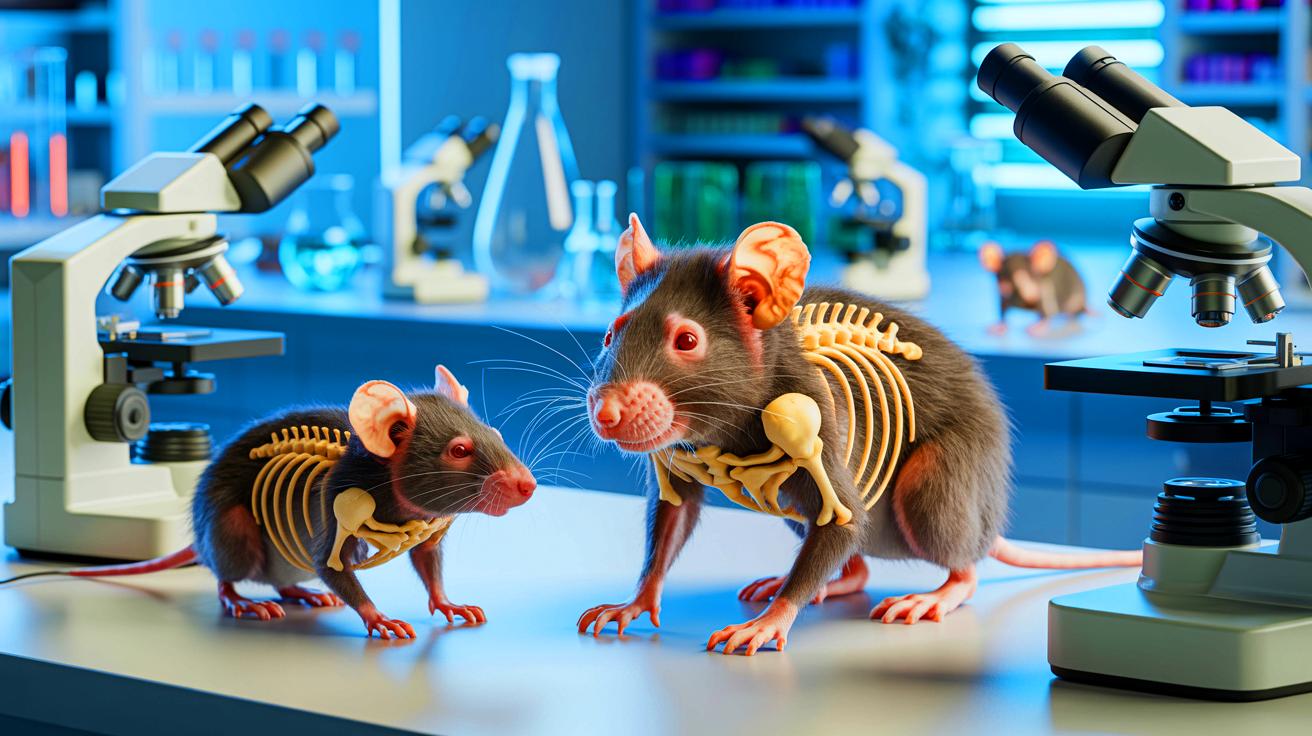IN A NUTSHELL
🔬 In a groundbreaking study, Japanese scientists injected 40,000-year-old Neanderthal DNA into mice to explore ancient human traits.
🧬 The experiment revealed profound skeletal changes in the mice, echoing Neanderthal anatomy and offering insights into human evolution.
🧠 The R1537C mutation showed that Neanderthal genes still persist in some modern human populations, particularly among non-African groups.
🔍 Researchers are examining how these ancient genetic variants interact with modern human genetics, influencing traits and evolutionary processes.
In an astonishing breakthrough, scientists in Japan have successfully injected 40,000-year-old Neanderthal DNA into mice, unveiling remarkable changes in their skeletal structures. This groundbreaking research not only offers new insights into the physical characteristics of ancient human species but also sheds light on how these traits might still influence modern humans. The study, conducted at the renowned Kyoto Prefectural University of Medicine, utilized cutting-edge gene-editing technology to explore the evolutionary journey of our species. As we delve deeper into the findings of this study, it becomes evident that the echoes of our distant ancestors continue to resonate in our genetic makeup today.
Scientists Revive Neanderthal Traits in Mice
In a meticulously controlled environment at the Kyoto Prefectural University of Medicine, Dr. Ako Agata and Dr. Tadashi Nomura embarked on a pioneering experiment. By leveraging the power of CRISPR technology, they inserted a single gene variant known as GLI3 into laboratory mice. This gene, present in both Neanderthals and Denisovans, holds the key to understanding the skeletal differences that existed between these ancient human relatives and modern Homo sapiens. The variant chosen for this study, R1537C, was specifically selected for its role in influencing bone and organ development during embryonic growth.
The primary objective of this experiment was to observe how this mutation might replicate the skeletal features observed in Neanderthal fossils, such as broad rib cages and elongated skulls. By inserting R1537C into the mice, the scientists hoped to recreate these ancient traits and gain a deeper understanding of the evolutionary processes that shaped our ancestors. Published in the prestigious journal BioRxiv, the findings of this research have captivated the scientific community and sparked widespread curiosity about the origins of Neanderthal skeletal characteristics.
Mice Exhibit Unprecedented Skeletal Changes
The results of this experiment were nothing short of extraordinary. The genetically modified mice began to exhibit physical traits reminiscent of Neanderthal anatomy, providing a tangible connection to our ancient past. Some mice developed broader crania, while others displayed signs of scoliosis-like spinal curvature and rib abnormalities. These changes mirrored the skeletal traits typically associated with Neanderthal remains, such as wider rib cages and stronger rib torsion, which have been documented in fossil records.
This experiment stands as one of the most compelling demonstrations of how specific ancient genes can influence skeletal morphology. The modified mice displayed these traits without experiencing severe developmental issues commonly linked to gene mutations. This suggests that the R1537C variant had a subtle yet profound influence on the mice’s development, offering new insights into the biological differences that separated early human species from modern humans. The implications of these findings are far-reaching, prompting researchers to reconsider the impact of ancient genetic variants on modern human physiology.
Neanderthal Genes Still Persist in Modern Humans
Intriguingly, the effects of the R1537C mutation are not confined to the distant past. This variant continues to exist in small portions of the modern human population, particularly among non-African groups. According to data from the 1000 Genomes Project, the mutation is present in 3.7% to 7.7% of European populations, with lower frequencies in African populations. This revelation suggests that certain Neanderthal traits may still be influencing human biology today, despite the extinction of these early humans over 40,000 years ago.
The persistence of genetic remnants from ancient hominins in modern genomes raises intriguing questions about their potential impact on traits such as bone development and susceptibility to specific conditions. As researchers continue to unravel the complexities of our genetic heritage, the study highlights the enduring legacy of Neanderthal genes and their role in shaping the human species. These findings underscore the importance of understanding how ancient genetic variants continue to influence the biology of modern humans, even as we evolve and adapt to new environments.
Examining the Impact of Ancient Genetic Variants
The research team is delving deeper into how this ancient gene variant interacts with the broader genetic background of modern humans. The study suggests that Neanderthals may have experienced relaxed constraints in their developmental processes, allowing mutations like R1537C to persist and contribute to distinctive skeletal features. This finding offers a fascinating glimpse into why some Neanderthal traits remain visible in present-day human populations.
While the modified mice did not exhibit severe deformities commonly associated with GLI3 mutations, such as polydactyly or abnormal limb development, researchers observed subtle yet significant changes in how the gene regulated developmental processes. This suggests that ancient hominin variants, while contributing to species-specific traits, may have played a crucial role in shaping both extinct and living human bodies. As we continue to explore the intricate interplay between ancient and modern genetics, the potential for discovering new insights into human evolution remains vast.
The groundbreaking study conducted by scientists in Japan offers a remarkable window into the past, revealing how ancient Neanderthal genes continue to shape the biology of modern humans. By injecting 40,000-year-old DNA into mice, researchers have uncovered profound changes in their skeletal structures, providing new insights into the evolutionary journey of our species. As we contemplate the enduring legacy of Neanderthals and their influence on our genetic makeup, one question emerges: How will our understanding of ancient genetics continue to shape the future of human evolution and medical science?
This article is based on verified sources and supported by editorial technologies.
Did you like it? 4.5/5 (20)

